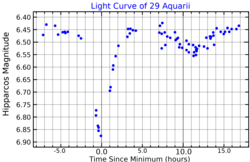29 Aquarii is a binary star system located around 590 light years away from the Sun in the equatorial constellation of Aquarius. 29 Aquarii is the Flamsteed designation; the system also bears the variable star designation DX Aquarii. It is a challenge to view with the naked eye, appearing as a dim star with a combined apparent visual magnitude of 6.39.[3] The system is moving further from the Earth with a heliocentric radial velocity of about +15 km/s.[3]
| Observation data Epoch J2000 Equinox J2000 | |
|---|---|
| Constellation | Aquarius |
| Right ascension | 22h 02m 26.24845s[2] |
| Declination | −16° 57′ 53.3959″[2] |
| Apparent magnitude (V) | 6.39[3] |
| Characteristics | |
| Spectral type | A2 V + K0 III[4] |
| B−V color index | 0.447±0.022[3] |
| Astrometry | |
| Radial velocity (Rv) | +15.0±4.3[3] km/s |
| Proper motion (μ) | RA: +5.292[2] mas/yr Dec.: +1.256[2] mas/yr |
| Parallax (π) | 5.5489 ± 0.1285 mas[5] |
| Distance | 590 ± 10 ly (180 ± 4 pc) |
| Orbit[6] | |
| Period (P) | 0.945 d |
| Eccentricity (e) | 0.00 |
| Periastron epoch (T) | 2,436,814.418±1.0 JD |
| Semi-amplitude (K1) (primary) | 97.9 km/s |
| Other designations | |
| Database references | |
| SIMBAD | data |
This is a spectroscopic binary system with a close circular orbit taking just 0.945 days to complete.[6] Despite their proximity, this does not appear to be a contact binary system.[8] The orbital plane of the two stars lies near the line of sight, so they form an Algol-type eclipsing binary. The first component of the system is an A-type main sequence star with a stellar classification of A2 V. Its companion is giant star with a classification of K0 III.[4]
The variability of this system was first noticed in 1965 by W. Strohmeier of Remeis-Observatory in Bamberg, Germany.[9] He later discovered that the variability was caused by a binary companion eclipsing the primary star.[10]
References
edit- ^ Molik, Petr. "Eclipsing binary DX Aqr". Sun Hill Observatory. Retrieved 16 October 2021.
- ^ a b c d Brown, A. G. A.; et al. (Gaia collaboration) (August 2018). "Gaia Data Release 2: Summary of the contents and survey properties". Astronomy & Astrophysics. 616. A1. arXiv:1804.09365. Bibcode:2018A&A...616A...1G. doi:10.1051/0004-6361/201833051. Gaia DR2 record for this source at VizieR.
- ^ a b c d e Anderson, E.; Francis, Ch. (2012), "XHIP: An extended hipparcos compilation", Astronomy Letters, 38 (5): 331, arXiv:1108.4971, Bibcode:2012AstL...38..331A, doi:10.1134/S1063773712050015, S2CID 119257644.
- ^ a b Zasche, P.; et al. (August 2009), "A Catalog of Visual Double and Multiple Stars With Eclipsing Components", The Astronomical Journal, 138 (2): 664–679, arXiv:0907.5172, Bibcode:2009AJ....138..664Z, doi:10.1088/0004-6256/138/2/664, S2CID 17089387.
- ^ van Leeuwen, F. (November 2007), "Validation of the new Hipparcos reduction", Astronomy and Astrophysics, 474 (2): 653–664, arXiv:0708.1752, Bibcode:2007A&A...474..653V, doi:10.1051/0004-6361:20078357, S2CID 18759600.
- ^ a b Paffhausen, W.; Seggewiss, W. (April 1976), "Spectroscopic orbits of the eclipsing binaries DV and CX Aqr", Astronomy and Astrophysics, Supplemental Series, 24: 29–34, Bibcode:1976A&AS...24...29P.
- ^ "BD-17 6422 -- Spectroscopic binary", SIMBAD Astronomical Object Database, Centre de Données astronomiques de Strasbourg, retrieved 2012-07-16.
- ^ Rucinski, Slavek M. (October 2002), "The 7.5 Magnitude Limit Sample of Bright Short-Period Binary Stars. I. How Many Contact Binaries Are There?", The Publications of the Astronomical Society of the Pacific, 114 (800): 1124–1142, arXiv:astro-ph/0207144, Bibcode:2002PASP..114.1124R, doi:10.1086/342677, S2CID 119453008.
- ^ Strohmeier, W.; et al. (1965). "Bright Southern BV-Stars". Information Bulletin on Variable Stars. 81: 1. Bibcode:1965IBVS...81....1S.
- ^ Strohmeier, W. (1966). "BV 449 and BV 600, Two Bright EB-Stars". Information Bulletin on Variable Stars. 164: 1. Bibcode:1966IBVS..164....1S. Archived from the original on August 18, 2013.
